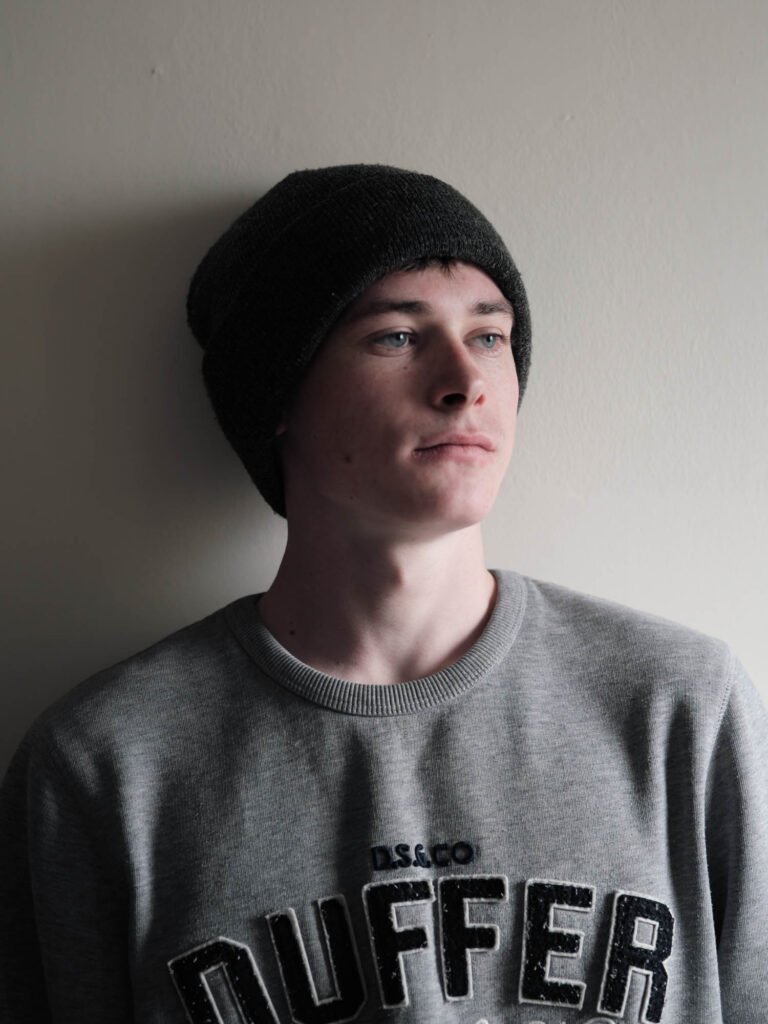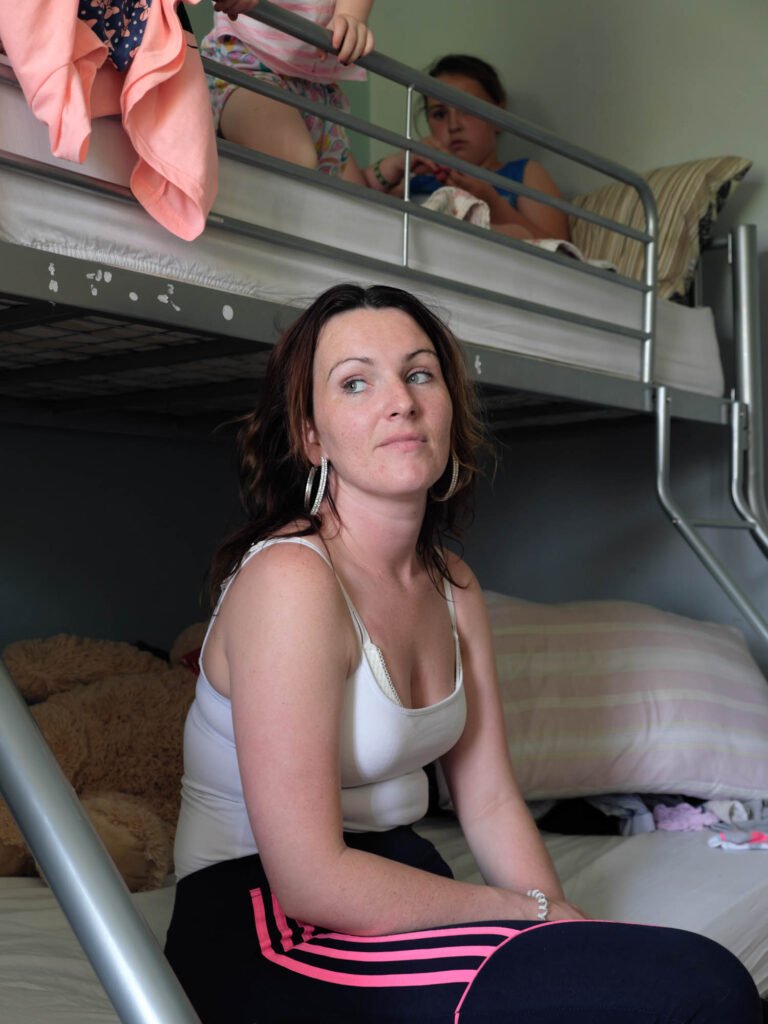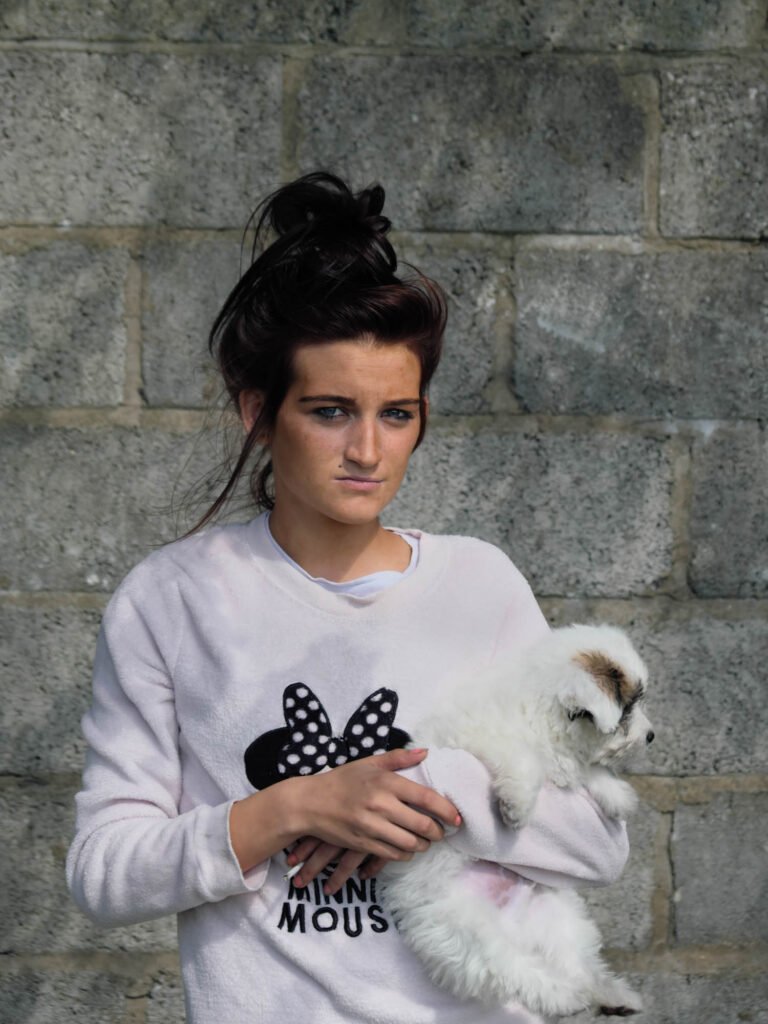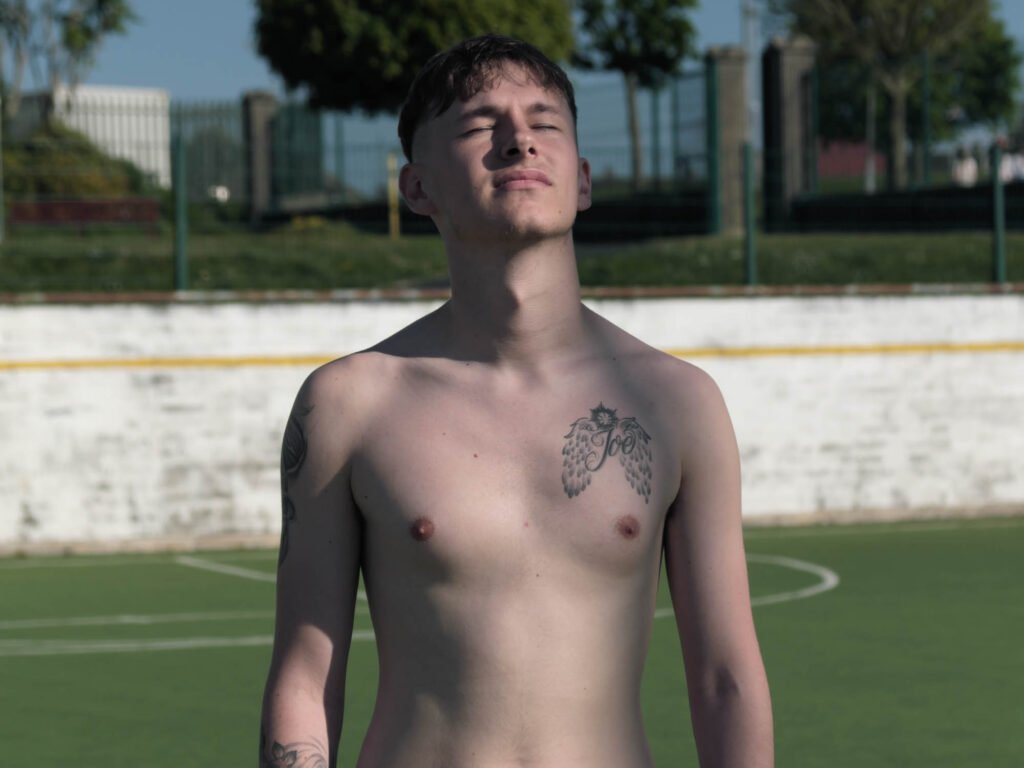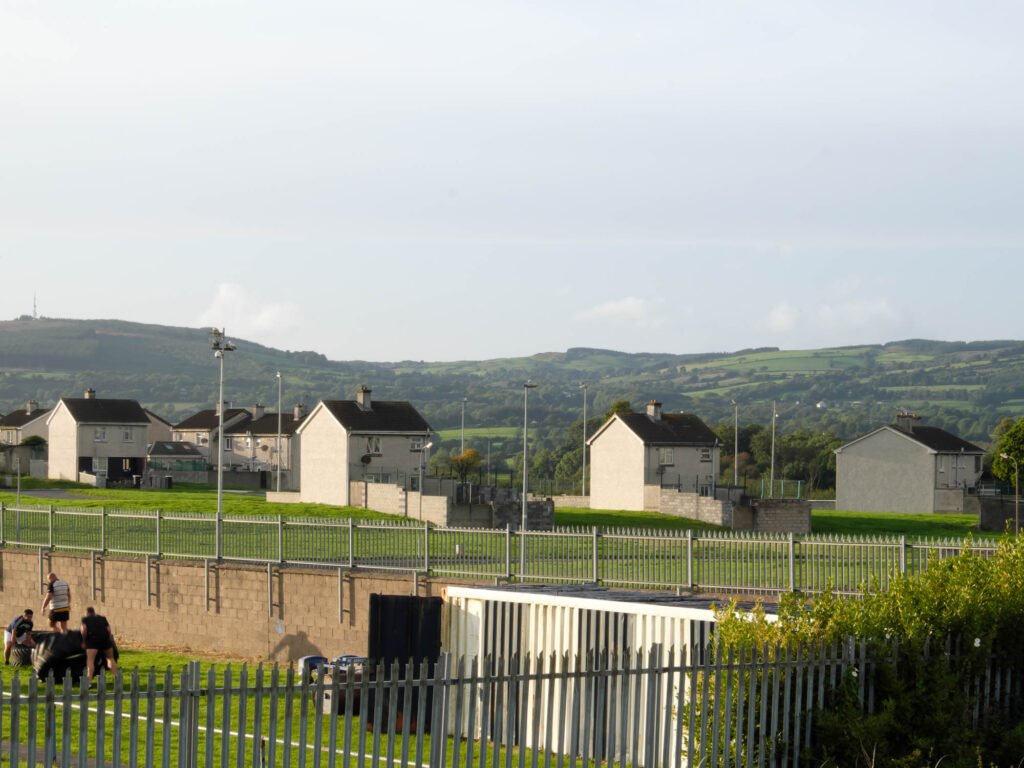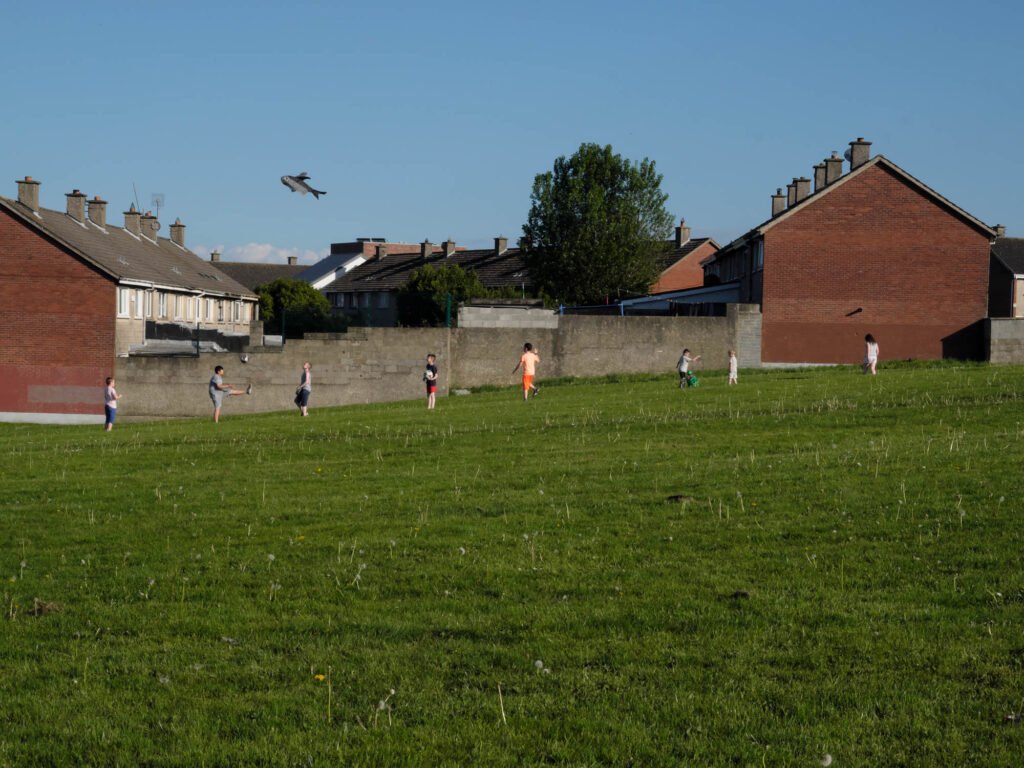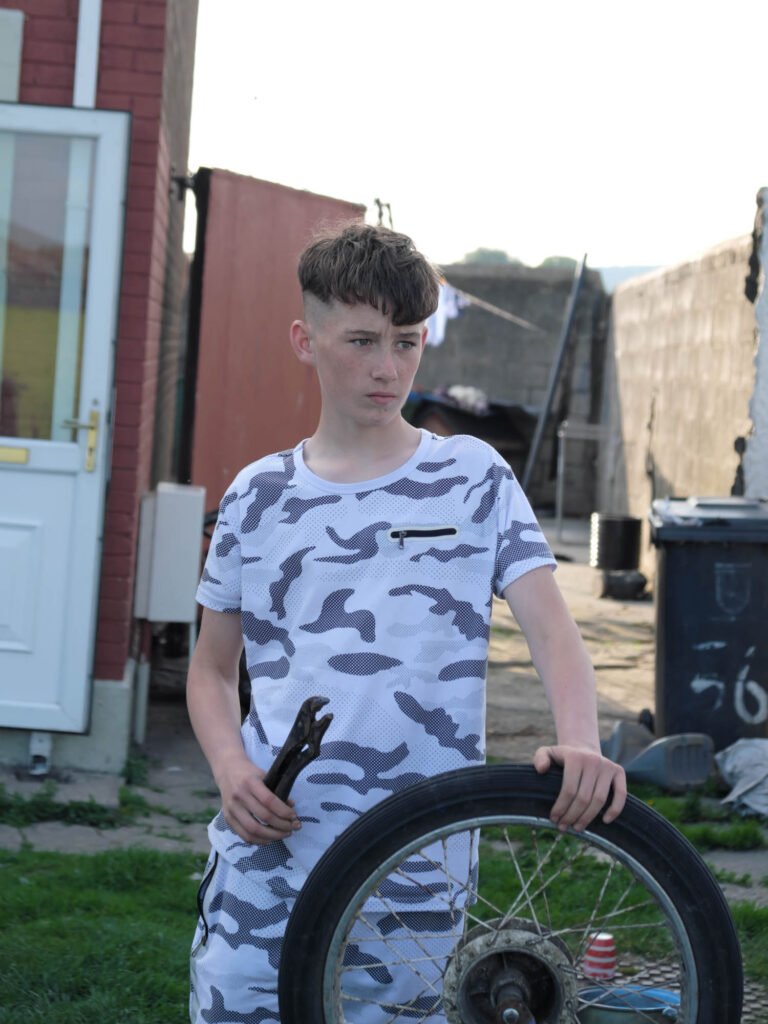Ilaria Sponda: Moyross Study is your investigation on the council estate of Moyross, located in Limerick. Could you say a little about this place?
Jamin Keogh: I guess to give a full understanding of Moyross and correspondingly my motivations for commencing this project, I will attempt to provide some succinct information of the community on the north-side of Limerick City. Moyross was constructed in the early 1970s as a solution to a growing housing crisis that affected lower income workers and council-housing applicants. After the new 1,200 unit, 3,200 + community’s initial years of hope and optimism had passed, and as a direct result of a continued lack of support and infrastructural and resource investment from Limerick city council and the Irish state, Moyross began to slip into a debilitating cycle of unemployment, a chronic lack of educational resources, anti-social behaviour, gun and gang crime, and ultimately, murder. This cycle of decline resulted in a landslide of overwhelmingly negative, stereotyped and degrading media coverage on the communities and young-people of Moyross being disseminated nationally and internationally, which, in turn, created and embedded the discrimination and prejudices experienced by the communities and young-people who currently live in Moyross. The cycle of violence in Moyross came to a head in 2006 when a car with 2 young children inside was set alight with petrol bombs by a number of teens. Following this incident, Limerick city council and the Irish state was forced to acknowledge their failings and role in the escalation of violence in Moyross and intervene. As a result of this intervention, a €3bn programme of infrastructural, social and educational resource ‘Regeneration’ was proposed in 2007 as a solution to the problems the troubled estate was experiencing (the initial budget of €3bn was cut to €300mil as a result of the collapse of Ireland’s Celtic Tiger economy in 2008). Soon after, with the goal of kick-starting a process of infrastructural, socio-cultural, economic, educational and psychological renewal, this programme of ‘Regeneration’ commenced. Hundreds of families were displaced, the bulldozers moved in, and a programme of house demolitions and topographical restructuring hastily began. This, process of ‘Regeneration’ has brought us to where we are today, 2021, as there has been minimal change.
IS: What made you start this project?
JK: This project started as a curiosity and became a reflexive need to tell a story of displacement, oppression, intergenerational trauma and societal inequalities. I initiated this project in 2017, as a response to my observations and as a way to comprehend and realise what was currently taking place within the community. I believe that the previous time that I had entered Moyross was in 2003, and structurally and socially, it was a very different place then. My early thoughts after my first 2017 visit was something along the lines of, it appeared as though a battle had taken place here, and this community had lost that battle. In the beginning, my sole interest was in the topography of the estate, the radical transformation of the social, psychological and physical landscape of Moyross under the banner of the Regeneration. One objective was to highlight to others in Limerick what Moyross was like in 2017 – Sadly, most Limerick people are unwilling to enter Moyross and as it stands that no one is really aware of what is going on there. There is, more or less, only one main entrance, with a perimeter fence and boundary wall going all around – CCTV camera’s every couple of yards you walk, similar to that of an open prison. One thing that first struck me was that, although typically with urbanisation, the city consumes and takes over the rural, here it is like the rural is now fighting back – green acres regrown within the gaps in the landscape where homes once stood with livestock roaming around freely. I was incredibly aware and sensitive of the complexities of entering Moyross with a camera. For years, the area has been under the sensationalizing spotlight of the local and national media and I did not want to be viewed as another outsider attempting to exploit the realities of people’s lives. As time passed and I spent more time there, the people became curious about me, and I became curious about them. At first, my approach was to document the transformation of the landscape, I was reluctant to include people in the project but, in time, it felt right because, at its core, the project is about a community, a community isolated on the edge of the city to the point of complete segregation. The community, the people, the faces within the series create a depth, that paves a way for the audience to connect, relate and perhaps prompt an emotive response. This project, Moyross Study, is an ethical enquiry to ongoing social and political issues – an examination at the human cost of displacement by exploring and making visible the gaps in the landscape – the lack of the housing are a representation of dislocation, corruption and greed.
IS: What kind of materials have you collected? How does photography interrelate with your overall research topic and interest?
JK: To supplement my overall practice, I would often seek out, research, and gather relevant materials, speak and connect with experts of specific fields that would empower me with an inadept understanding of the subject matter, whatever that topic maybe. My sources of inspiration are mainly enthused by theoretical, philosophical discussions in combination to a fact-based research process. For example, A Constant Parameter (2014-2019) is a body of work and research created around an artistic, scientific and philosophical exploration of the phenomena of coastal horizon lines, human perception and subjectivity. The work approaches its subject matter in a joint process of research-based inquiry and site responsive physical engagements. A significant element of my creative process for this work includes moving past what the founding-father of the philosophical tradition of Phenomenology, Edmund Husserl, called the ‘natural attitude’, and what the hermeneutic-phenomenologist Martin Heidegger termed as: the everyday, ontic way of understanding the world and the things that can be said to exist. This element is the driving force of what this project now contains – a tangible attempt to capture a definitive movement past the limitations of traditional interpretations and understandings. Contributions for this particular project were drawn from specialists working in the academic disciplines of Applied Physics; Optics; Engineering; Cartography; and Philosophy. For Moyross Study, I had accessed Limerick City Council records and reports, and I studied the Limerick Regeneration Masterplan. I had come across some audacious statements in that masterplan report that were prompting more questions tin me rather than answers. In one instance in May 2018, I had been invited for an interview and debate on local radio in Limerick. To prepare for this, I needed to be informed of all the facts. I contacted the Limerick City Council and requested relevant reports. To answer the second part of your question; although, I have a spent a considerable amount of time working with photography and examining its role within society and culture, however just to say that for a long time I did not consider myself to be a ‘photographer’ in the traditional sense. Photography was simply the medium that I utilize to respond, articulate and communicate my creative representations. It was not until I initiated this seriesthat I embraced being a photographer. There was a weird sense of acceptance. Moyross Study was my first time doing environmental portraits for example, and as mentioned, I had I resisted to include portraits within the project – but those portraits were pivotal for me engaging with the community.
IS: Part of your work features a Google Street View’s mapping of Moyross housing estate. What have you noticed using this tool as a way of seeing?
JK: When Google Street View was introduced in May 2007as a way for users to “quickly and easily view and navigate high-resolution, 360-degree street-level imagery of numerous locations around the world.” I guess Google Street View allows for an emotive and explorative way of seeing the world, to reconnect the viewer with times past, a memory of place and a means to explore the world in 2D. But I have a tendency to ask questions of platforms such as Google Street View, where there is too much power for the developers of this mechanism. Just how accurate can it be? Who decides on the politics of representations? Who controls what and where the viewer can navigate, what is included and or withheld and to what end?
IS: At the core of Moyross Study lies the issue of representation and the social relations shaped by its politics. Moyross’ people are present in the territory but their presence is limited, and this is clear from the fact that the neighbourhood’s representation on Google Street View is “out of date” as you say, apparently for “operational reasons”.
JK: The inclusion within the project of the Google Street View mapping of Moyross is a response to the sociological study that I had come across: ‘Why bother seeing the world for real? Google Street View and the representation of a stigmatized neighbourhood’, by Martin J. Power, Patricia Neville, Eoin Devereux, Amanda Haynes and Cliona Barnes. This essay adopts a rhetorical/structuralist methodology to analyse how Moyross is represented (and not represented) by Google Street View. In spite of Google’s claims that Street View allows for a virtual reflection of the real world to enable armchair exploration, this study shows how it is directly implicated in the politics of representations. In 2010, Google Street View mapped 55,000 kilometers of Irish villages, towns and cities. Initially, Moyross was omitted from Google Street View, with only partial and restricted glimpses of the estate being offered from nearby peripheral vantage points. This initial mapping of the estate was not received well by residents or their elected representatives. Under pressure from community groups and local activists, the Street View car was re-deployed in 2010, and again in 2017, to continue its street imagery of Limerick City. Since then, Street View has mapped the internal structure of the estate. However, the ‘updated’ images continue to inaccurately portray the neighbourhood in that they remain significantly out of date. While Google has said that these omissions were ‘for operational reasons’, this study argues that a wider set of social and ideological beliefs and practices influenced Google’s decision to map Moyross in this way. One can only speculate as to why the initial exclusion of the community was created and permitted Within this then, not only is Moyross discriminated and marginalised by socially and in the physical world, but this could be interpreted as a mode of digital marginalisation.
IS: How does the idea of space as “a social product” (Lefebvre 1992) come into the way you portray Moyross and its individuals? How do you restitute them of their right to representation?
JK: After my first visit to Moyross in 2017, I had commenced asking particular questions, but it wasn’t until I was deep into the project that I formed connections with Lefebvre’s writings and what I was observing and examining.I had become familiar with the writings of Lefebvre during my undergrad days. His argument is that space we inhabit is not a natural given, but instead is an abstract, social construct based on economic systems, hierarchical power structures and the class system, which shapes human perception and limits agency and autonomy. Space is produced to appear natural. However, the world is not ready made – always ask, who built this space and to what end? These theories of space are utilised to tell the story of Moyross, why it was constructed, its orientation, its history and its future. This project is a story about a particular type of space and how the agenda and decisions of those in power have affected the community that reside within it. Lefebvre also helps to contextualize the role of the ‘Regeneration Project’. It is perhaps pertinent to note that here, in the context of Lefebvre’s work, I understand the term ‘Regeneration’ as basically being synonymous with the terms of control, oppression and exploitation of a community.
IS: Your images raise awareness of the housing and social crisis in Ireland. Uncomfortable thoughts about endangered living conditions and poor governmental actions are brought up by your study. Is this intentional? Where do you wish your work to be seen in order to activate change?
JK: It was not intentional. I was not aware of my intentions until I became more invested in the work and the community. But, it is fair to say that alarm bells were certainly ringing from the get-go. 2017, Ireland is in the midst of a housing crisis. Why are their barren acres of land that once occupied solid functional homes? Why were those homes demolished? Where did the people go? As it stands, Ireland has no constitutional or legally established right to housing. Also, it is worth highlighting that according to the United Nations Office of the High Commissioner for Human Rights, 1991;“adequate housing” must be affordable, habitable, and accessible to disadvantaged groups. It should include security of tenure, availability of services, materials, facilities and infrastructure. Its location must allow access to employment, health care, schools, childcare centres and other social facilities. This is not congruent to the Irish states policies affordable housing and access to education. The sociology of community is an extensive area, and it has interesting intersections with geography, political ecology and social anthropology. For me it is important to discuss the boundary wall here, or simply ‘the wall’ as it is referred to within the community. This wall is a clear example of how class plays out in the politics of place and how public spaces become a physical manifestation of marginalization. The boundary wall, the physical and psychological, ‘The Wall in the head’ that separates the community from nearby local educational establishments, is also powerfully symbolic. Who is higher education for? The wall sends a powerful psychological message, it’s not for the community of Moyross. And simultaneously, we might ask, what is higher education for? It is important that conversations are prompted around these realities. For me, it is crucial to bring to light unsatisfactory decisions that affect the human rights of the people inhabiting social class communities. According to the latest relevant study on the issue of equality under discussion, the 2019 Updated HP Deprivation Index commissioned by Pobal, it is now clear that this 10 year programme of ‘Regeneration’ has failed. Using data from the 2016 census, Pobal’s ‘Deprivation Index’ demonstrates a clear lack of progress in reaching the goals of ‘Regeneration’. According to the index, homelessness, deprivation and social exclusion in Moyross is worse than it was before the programme of ‘Regeneration’ began, with unemployment for men and women standing at close to 70 and 45% respectively, and 56.8% of Moyross’ population dependent on social welfare payments. The population of Moyross has also dramatically decreased, suffering a loss of close to 60%, with only 1,962 people now residing in the housing estate. Accession to third-level education for the population of Moyross is also at an all time low, coming in at just under 2%. 35.3% of Moyross’ population leave the education system after completing primary level, with a further 61% leaving education after completing the junior certificate cycle. When compared to similarly sized, but more affluent parts of the country, life expectancy in Moyross’ population is 6.5 years lower for women, and 7.5 years lower for men (PobalHP Deprivation Index, 2019). The suicide rate in Moyross and the surrounding areas is also regularly amongst the highest in the state, and crime, drug-dealing and gang violence are still prevalent factors for many residents of the housing estate. What the remaining young-people and community of Moyross have been left with then, after this failed programme of ‘Regeneration’, is the deeply distressing social, economic, psychological and cultural experience of living in a highly stigmatized, penal like space, surrounded by oppressive boundary walls, the once densely populated estate now a sparse landscape dotted with 58 advanced CCTV cameras all positioned with only surveillance and control in mind. Since the Regeneration commenced in Moyross, 600 homes have been demolished, and only 46 have been constructed. Within the context of COVID-19, like many communities around the country, the lockdown has amplified the issues within the community homelessness, mental health and addiction issues. They are prevalent in this community as they are in many of the communities throughout the country. And one of the issues that we would see here that have been exacerbated by COVID-19 Lockdowns is the level of overcrowding that exists in the community that has come about because of the scale of demolition over the last 14 years to massive overcrowding in homes with three to four generations of families have been the one home resulting to 12 or 13 people living a three-bedroom house. I believe that the work would be best received and acknowledged in my home city of Limerick, Ireland, however, gentrification and marginalization is understood and recognized universally.
IS: Is the project still ongoing? What are your next steps?
JK: Yes it is, with full intention. I had planned to return to the community in 2020 during my university summer break to resume the project, however, the Covid-19 lockdowns put a stop to that. I do feel it is necessary to continue this journey with this community, to have their story told and shared. I intend to display the work within the community and to create a publication of this large body of work.
IS: How do you place Moyross Study within the evolution of your work as a whole?
JK: In regard to my evolution of as a photographer; I became fascinated by photography when on an art portfolio course. I then went on to study a BA (Hons) in Photography at the Dún Laoghaire Institute of Art, Design and Technology (I.A.D.T). I graduated in 2013 with a first-class honour’s degree. After working for a time as freelance photographer and photographer’s assistant for commercials. I was also simultaneously working in a Photography gallery. This allowed for me to remain connected with both the art and commercial tiers of photography. I then returned to education, again with I.A.D.T for a 2-year Masters in Art and Research Collaboration, which I completed in 2016. However, looking back, you could say that I have always had an interest in creating socially engaged work, not just in a self-initiated project capacity. Certainly, my time at college was at the midst of a decade of economic crisis in Ireland, which has thrown into relief certain social and political issues I’ve tried to reflect and stimulate thoughtful discussion about. Even before the Moyross Study, I spent significant amounts of time researching a separate project, Points of Entry, which examines suicide clusters within a community and Limerick’s high suicide rate. That project was put on hold as the Moyross Study took over but, in both, I was also as interested in a reflexive examination of the relationship between documentary photography and art – which to me feels somewhat strange, as prior to engaging with these topics, I would never have described my work to be of a ‘documentary’ nature. Furthermore, the continued unravelling of this project inspired me to go on to complete a Masters in Applied Social Science at that National University of Ireland, Maynooth. I fortunate to graduate in October of this year with a First-Class Honours. I am now a qualified community and youth worker which enables me to have a deeper of sense of politics, polices and of human-rights frameworks. People residing in social class communities often experience a sense powerlessness in engaging with state organisations and their continued inability to access basic human rights that many of us would take for granted. These communities are often impacted in terms of their inaccessibility to their right to education, right to housing, amenities and social services, and the right to employment, in terms of being discriminated against because of their social origins. These are all basic human-rights that if not adhered to cause significant inequalities. This lens of a social justice practitioner has enabled me to distinguish the difference between equality of opportunity and equality of condition. Equality of condition refers a “strong commitment to the protection of liberal rights, to a participatory democracy that favours a process of decision-making inclusive of widespread participation of ‘ordinary’ people, and a form democracy that extends democratic practices across all social institutions and apparatuses.” I had investigated case studies of other social class communities within Ireland that had endured a social regeneration plan. Similarly, to Moyross, these plans were introduced to tackle poverty and social exclusion under eight social themes. One community in Dublin, known as Fatima Mansions, achieved a Regeneration on their own terms that was based on the needs that were identified by those residing in the community, and not by third party agencies. The Fatima Mansions achieved their objectives of a successful regeneration through a community work process with placed emphasis on collectivity, active leadership, human rights, sustainable development, empowerment, advocacy, collective action and active participation. My role as community worker is to work and engage with oppressed communities, to mitigate those omnipresent societal inequalities and to ensure that those that are experiencing powerless by design, are brought to the table to have their voices heard and to ensure that they have a say in the decisions that affect their own lives.
Jamin Keogh (b. 1982) is a lens based artist. He holds a First Class Honours Degree in Photography (IADT), a Masters in Art and Research Collaboration (IADT), and first class honours of the Masters in Social Science programme from National University of Ireland, Maynooth (NUIM). Jamin has been involved with art practices as an artist, curator, and a visiting lecturer at numerous Irish third level institutions.
During his time at IADT, Jamin’s work was nominated to represent the institution on the European art circuit at ELIA NEU/NOW and Le Bal. His work has been short-listed for the Inspirational Arts Award, and been shown at the Irish Museum of Modern Art (IMMA). In 2018, Jamin’s project: Moyross Study was exhibited as part of the main series of exhibitions at PhotoIreland, and was selected to represent Ireland at the prestigious European photography festival Unseen Amsterdam as part of the inaugural FUTURES Platform. In 2019, the artist’s long term research project, A Constant Parameter, was selected by international jury to part of the triennial, New Irish Works. The project was presented for the first time at Museum of Contemporary Photography of Ireland, at Dublin Castle.
During the creative process, Jamin draws inspiration and meaning from subjective human reactions to life experiences and merges audiovisual media into his photographic expressions, placing an emphasis on the role of the spectator within the artwork’s space. This was demonstrated in the deeply layered psychological installation, All That Remains To Be Seen.
His practice is often infused and underwritten by philosophical discourses such as: Martin Heidegger’s theories and philosophy of ‘Human-being and Art’; and Emmanuel Levinas’ theories and philosophy of ‘the Face’ and ‘the Other’.
In Moyross Study, Jamin responds to Henri Lefebvre’s The Production of Space (1974). Lefebvre’s argument is that space is not a natural given, but instead is an abstract, social construct based on economic systems, hierarchical power structures and the class system, which shapes human perception and limits agency and autonomy. Jamin also considers Lynsey Hanley’s insightful text: Estates: An Intimate History (2007), in which the author describes the overwhelming sense of segregation that exists in communities situated in social housing developments such as Moyross.

